Wildfire Prepared Home
Get your property designated with the Wildfire Prepared Home through a premier partner assisting you every step of the way.
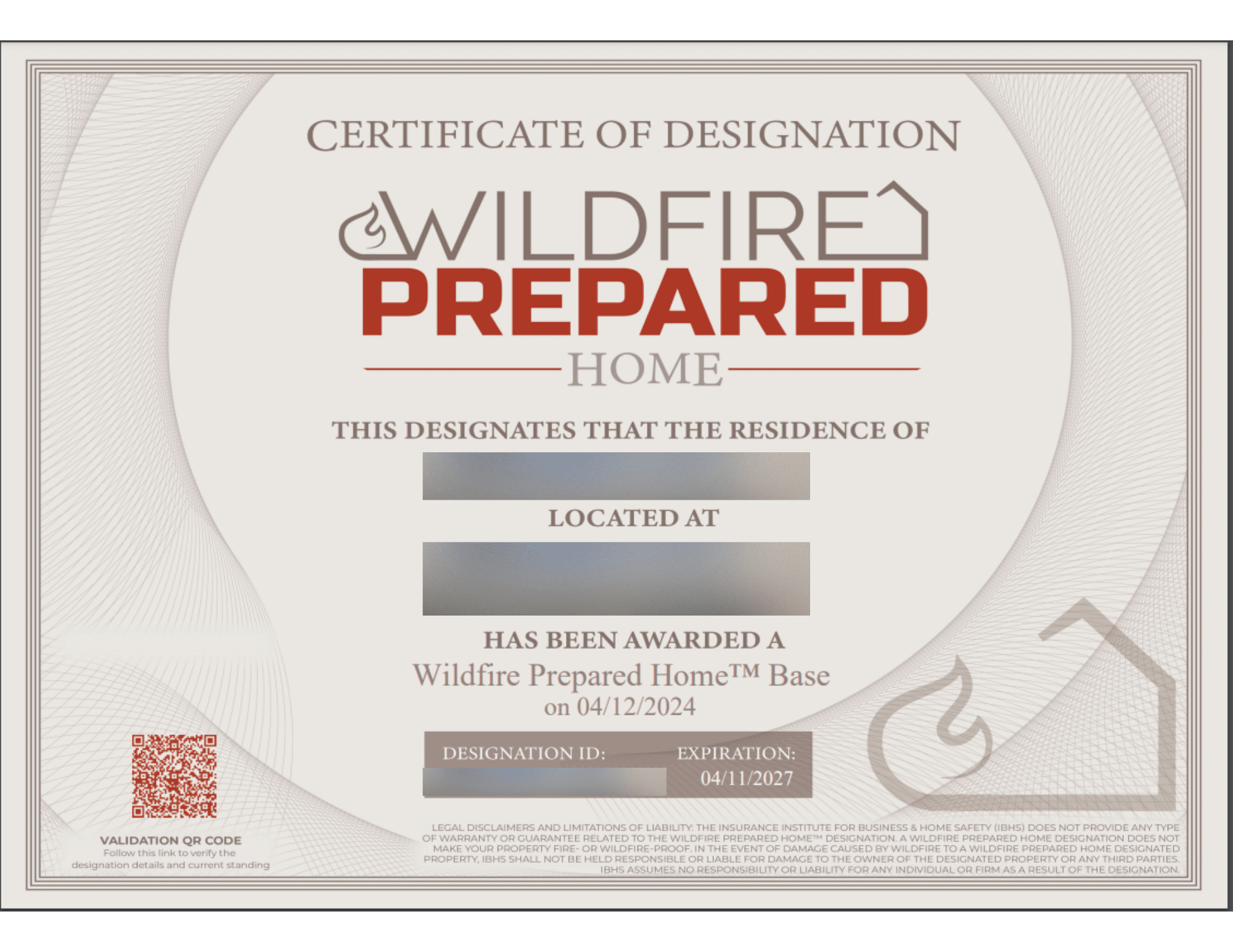
- 0-5 Ft Vegetation Clearance
- 5-30 Ft Vegetation Management
- Non-Combustible Fencing
- Ember-Resistant Vents and Mesh
- 6 Inch Vertical Clearance
- Clear Debris from Roof and Gutter
the Process
There are many requirements that are needed, review the video explanation and the guideline.
How it Works
We conduct an on-site pre-inspection of the property to identify what your property needs to get to the Wildfire Prepared Home standard, provide you with investment options, perform the work, document and verify the work to submit to IBHS for designation.
Not every house will be able to qualify to get the Wildfire Prepared Home Designation due to the way the home is built, the land, and the surrounding environment. There is no guarantee of receiving an designation.
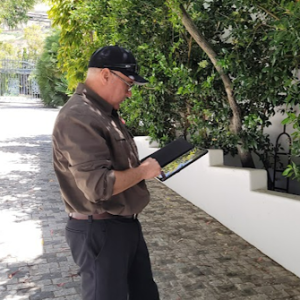
Step 1: Wildfire Risk Assessment
We conduct an initial assessment to identify all recommendations to bring your home up to a Wildfire Prepared Home Standard. You will receive a report of what items need to be addressed, such as removal of vegetation within 0-5 feet, and if your property needs to install ember-resistant vents.
15 Minute
Phone Consultation-
Best for if you have questions
-
Want to learn about the process
-
Want to talk to someone live
Virtual
Assessment-
Submit 4 photos/videos
-
Get on a live call with an expert
-
Receive a quick summary of items you need to address
Wildfire Risk
Assessment-
On-site inspection with an expert
-
Full comprehensive report of recommendations
-
Investment estimate for performing the scope of work recommended
Please note that these fees do not include the $125 application fee that homeowners need to pay direct to IBHS.
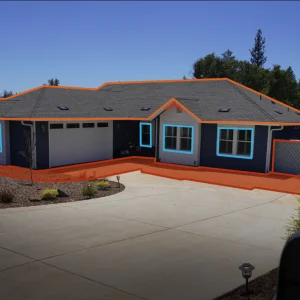
Step 2: Investments
Along with the report you receive, you will have the scope of work identifying how much you need to invest to bring your property up to standard.
For the standard home, you can expect to invest $1000-2000 to remove/maintain the vegetation around your property. We recommend you use gardeners or landscapers of your choice after receiving the report of what needs to be done.
For the structural improvements such as the installation of ember-resistant vents, you can expect to invest $2500-4000. Our team will order the material, vents, and handle the installation process.
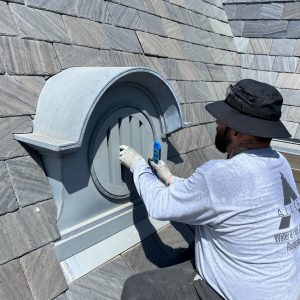
Step 3: completing the work
If you choose to go with us to perform the investment options provided, you can expect a timeframe of 1 month to have the work performed. Our team will schedule a date for installation of ember-resistant vents and vegetation management.
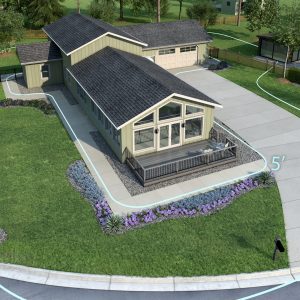
Step 4: Document & Verification
Once all the work is completed, you submit all the photos and verification direct to IBHS and pay the $125 application fee.
I wanted to let you know that April Schwartz recently assisted me and my husband in March 2024 in submitting our application for the WPH certificate. When we initially contacted Allied, we were feeling stressed and confused because our homeowner’s insurance through Farmers was going to expire on 6/6 unless we obtained the WPH certificate. April was kind and patient as she explained the services your company provided. I recognized that Allied’s services along with April’s helpfulness and guidance would be worth the nominal cost in obtaining the certificate. April inspected our home March 20th, took pictures and explained what corrective measures needed to be taken. Her knowledge and experience as a firefighter was reassuring as she inspected our home. After we received our inspection report, we sprung into action to get the recommended work done. April was a lifesaver in reviewing our photos and providing her input prior to submitting our application and final photos to the IBHS. I let her know how concerned I was about receiving the WPH certificate in time to submit to Farmers before our policy expired. April took action and was able to expedite our application quickly. Our application was submitted on 5/20, reviewed on 5/23 and approved on 5/24/24. I submitted the WPH cert to Farmers on 5/24 and they renewed our policy on 5/30/24! We are so very grateful and appreciative that April helped us during this very stressful process. Her expertise, empathy, patience and kindness made all the difference in our endeavor. I think that April is huge asset as an employee to your company. I commend Allied Disaster Services in providing these invaluable services to assist homeowners like us during these uncertain, stressful times.
Taryn and David
![WildfirePrepared_logos[74384]-2](https://allieddisasterdefense.com/wp-content/uploads/elementor/thumbs/WildfirePrepared_logos74384-2-q194pjdk4718y42iacmhyakrq9gxadno3t4fwsuifk.png)
Allied Disaster Defense – A Premiere Partner
Get Your Property Designated as a Wildfire Prepared Home
FAQ
Wildfire Prepared Home was developed to help protect your home from wildfire, based on years of scientific research by the Insurance Institute for Business & Home Safety (IBHS). All the required mitigation actions must be met for your home to qualify. Once we’ve completed all required mitigation actions, we will provide you a code to apply for a designation.
Wildfire Prepared Home is the first-ever wildfire mitigation designation program. It allows homeowners to show their insurance company they’ve taken the critical set of science-based actions needed to meaningfully reduce their home’s wildfire risk, distinguishing it from partially or unmitigated properties.
Much more than another set of tips, Wildfire Prepared Home includes built-in homeowner education, a system of required mitigation actions, a verification process, and an annual requirement to ensure ongoing landscape maintenance.
While designations are currently only available for single-family homes of three stories or less in California, the requirements are recommended for all homes to reduce wildfire risk. Eligibility for designation may be extended to other building types and locations in future versions of this standard.
Importantly, to ensure better protection against wildfire, the requirements of this standard are stringent. Therefore, it is not easy to earn a designation, and some homeowners may have to work with neighbor(s) to meet the requirements. Homeowners who do achieve a designation will reduce their risk and have better peace of mind when wildfire threatens.
Wildfire Prepared Home balances achievability, while meaningfully reducing risk. No home is fireproof. Yet, a system of actions can limit the catastrophic reach of wildfire as it approaches neighborhoods.
How much does it cost?
The average inspections cost $750 for the average size home in our service area. We charge additional for properties out of our service areas that require additional drive time.
What do I need to prepare?
Review the video explanation we have above and IBHS Wildfire Prepared Home Guideline. After understanding the scope of work required and the investment is within budget, then schedule an inspection with us to get started.
How long does the assessment take?
Most assessments take up to 2 hours depending on the size of the property.
Do I need to be present during the inspection?
No, but it is recommended to be present. We will need access to the property and a point of contact.
What is the timeframe from start to finish?
Estimated 6-8 weeks. We can schedule an assessment within a week. You will receive the reports and investment options 1 week after your assessment. It will take 4 weeks to complete the work and 2 weeks for IBHS to review.
Is this different from the defensible space inspection done by the fire department?
The Wildfire Prepared Home Inspection is not the same as the defensible space inspection. The fire department inspection does not count as a Wildfire Prepared Home inspection to qualify for the designation. You will need a certified inspector with IBHS to confirm and verify the work has been completed up to standard.
Is the report shared with Insurance Carriers?
No, we do not share the report and findings with insurance carriers without your permission.
How many vents do I need?
Title 24, the California Building Energy Efficiency Standards, requires a 1/150 calculation for minimum residential attic ventilation. This means that for every 150 square feet of enclosed attic space, 1 square foot of ventilation is required.
How do Ember Resistant Vents work?
Ember-resistant vents are a relatively easy solution to the ember intrusion problem. Ember-resistant vents are made to prevent embers from entering the home and starting a fire. There are three types of vents that are approved by the Office of the State Fire Marshal (OSFM). Each approved vent functions differently.
While ember-resistant vents are effective at stopping embers, they do have varying levels of restriction to the attic and foundation ventilation.
There are ways to modify existing vents with special ember-resistant mesh, however, while effective, this method is not currently listed and approved by the OSFM.
Effect of ember-resistant vents on a home’s ventilation system:
Which vent will work for me?
Considerations when selecting ember-resistant vents include cost, availability (custom vents) and most importantly the effect that the vents have on your home’s ventilation system.
Do I need an ember-resistant vent on my chimney?
In California, chimneys are required to have a Chimney Cap Spark Arrestor. Spark arrestors are different from ember-resistant vents.
Ember-resistant vents are designed to keep embers from a wildfire from entering vulnerable areas of the home by limiting the size of the mesh openings to 1/8 and as small as 1/16 of an inch.
Chimney cap spark arrestors are designed to keep embers from a fire in the fireplace from exiting the chimney and landing on the roof or on combustible material on the ground. Spark arrestors generally consist of double layers of metal mesh that are 1/2 and no smaller than 3/8 of an inch. This mesh can catch embers, yet still allow gasses and smoke to exit the chimney efficiently.
Placing an ember-resistant vent on a chimney could interrupt the thermal flow of the chimney gasses causing smoke and carbon monoxide to back up into the home.
Contact Us
- 310-620-9442
- 3120 E. Garvey S. West Covina CA 91791
- 24 Hour Emergency Disaster Service
- NFPA Member
